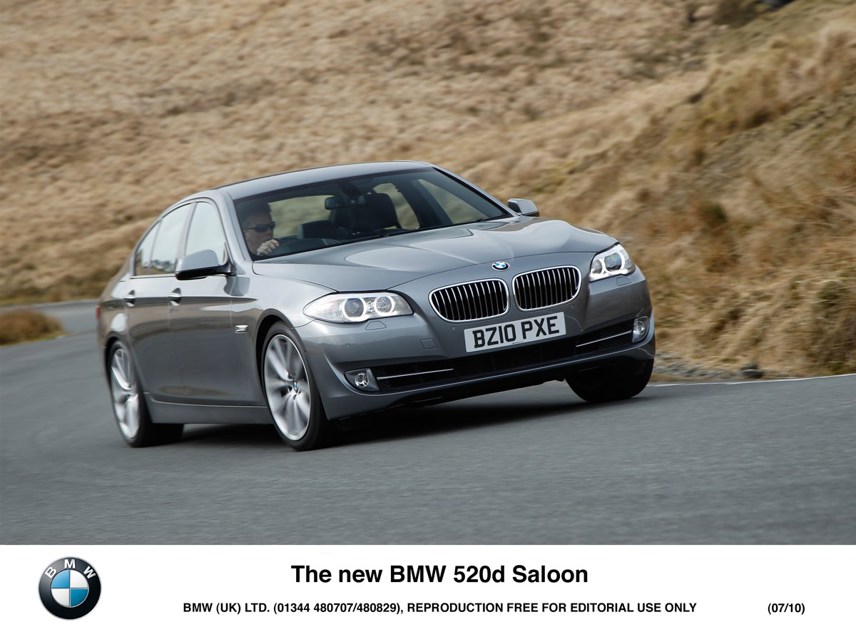Review
Three years ago BMW began adopting new technology across its range that thrust its models to the top of their classes for CO2 emissions and fuel consumption.
It was called EfficientDynamics and included a variety of measures, some or all of which were put in place across the range.
The BMW 5 Series didn’t receive the same level of EfficientDynamics as the 3 and 1 Series, but the new 520d brings it into line. It will take the bulk of 5 Series saloon sales (about 70%) and four-cylinder diesel is the backbone of the executive saloon sector in the corporate market.
For the first time, the 5 Series has stop-start technology as part of its EfficientDynamics package and the first variant to benefit is the 520d.
BMW has been able to move forward with its low-CO2 technology on the latest 5 Series, and while the automatic versions of the 525d and 530d hit 160g/km, the manual 520d delivers a no less impressive 129g/km.
Its power output of 184g/km is equivalent to the BMW 530d of 1998, but even though we thought the 530d of that era was mightily impressive at the time, that car’s CO2 emissions were 189g/km.
Back then, hardly anything on the road had CO2 emissions as low as 129g/km.
So it shows some of the astonishing progress made during the last decade as well as how savvy BMW has become in realising its buyers now take CO2 emissions very seriously.
Choose the new eight-speed automatic transmission option and CO2 jumps just 8g/km to 137g/km.
Fuel consumption for the manual 520d is quoted as 57.6mpg (auto: 54.3mpg).
Compared with the outgoing EfficientDynamics model it replaces, the new 520d has 7bhp more, but CO2 emissions are 7g/km lower.
However, when the previous BMW 520d began life in 2005 its power output was 163bhp and CO2 emissions were 158g/km.
BMW claims the 5 Series is better value than before with several key items of equipment fitted as standard on the entry level SE grade, including leather seats, Bluetooth integration, automatic dual-zone air conditioning, automatic headlights and iDrive interface with shortcut buttons.
The 520d SE also comes with 17-inch alloys as standard so despite its strong green credentials, it doesn’t look like an economy version.
The interior seems a bit plusher than in the previous 5 Series, too, with more expensive feeling materials used on the dashboard and doors.
Its 2.0-litre engine purrs quietly with no unpleasant noise intrusion and with a broad torque band – the maximum of 280lb-ft is available from 1,900-2,750rpm.
The 520d feels beautifully balanced on the road, although owners have the choice of tailoring the driving experience to a more focused set-up through the options list, with active steering (£1,300) and variable damper control (£965) while M Sport derivatives come with lower, stiffer suspension.
For the first time, customers may choose the M Sport derivative while retaining the SE suspension set-up. It keeps the M Sport styling, but some customers may prefer the more compliant ride of the SE.
Verdict
The 520d’s ultra-low CO2 emissions and exceptional frugality with fuel are just two attractive features of a very compelling package.
Although its rivals are also good, almost all objective measures point to the new 520d being a better product.
Author:
Simon Harris
Specs
| Manufacturer | BMW |
| Model | 5 Series |
| Specification | |
| Model Year | 0.00 |
| Annual VED (Road tax) | £0 |
| BIK List Price | £30,375 |
| CO2 | 125g/km |
| BIK Percentage | 20% |
| Insurance Group | N/A |
| CC | N/A |
| Fuel Type | Diesel |
| Vehicle Type | |
| Luggage capacity (Seats up) | N/A |
Running Costs
| P11D | £30,375 |
| Cost per mile | 47.00ppm |
| Residual value | £11,565 |
| Insurance group | N/A |
| Fuel Type | Diesel |
| Cost per mile | 0.00ppm |
| Fuel | 0.00ppm |
| Depreciation | 0.00ppm |
| Service maintenance and repair | 0.00ppm |
Info at a glance
-
P11D Price
£30,375
-
MPG
58.9 -
CO2 Emissions
125g/km -
BIK %
20% -
Running cost
3 Year 60k : £11,565 4 Year 80k : £9,000 -
Fuel Type
Diesel
















